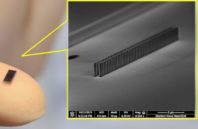If electron accelerators could be made small and cheap enough, not only would every university be able to afford its own accelerator laboratory, but inexpensive coherent x-ray beam sources for photolithographic processes in the semiconductor industry could be made available, which could reduce transistor size in computer processors and increase integration density. For medical use, accelerator-based endoscopes could be used to irradiate tumors deep within the body with electrons.
The Accelerator on a Chip International Program (AChIP), funded by the Gordon and Betty Moore Foundation in the U.S., aims to create an electron accelerator on a silicon chip. The fundamental idea is to replace accelerator parts made of metal with glass or silicon, and to use a laser instead of a microwave generator as an energy source.

 (585) 768-2513
(585) 768-2513

